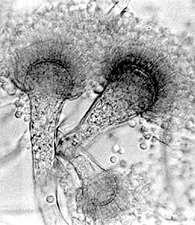Collection Provides Supply for Taxonomical Rescues

(PhysOrg.com) -- The Agricultural Research Service maintains some of the world's largest publicly accessible collections of microbes that are used to benefit agricultural sciences. But some smaller ARS collections are critical to the day-to-day work of career scientists working at specific locations. Such is the case of the Fungal Culture Collection housed at the ARS Southern Regional Research Center (SRRC) in New Orleans, La.
For nearly 30 years, the collection’s 1,700 strains have been curated by taxonomist Maren Klich. She chose a method of preserving the collection that essentially is the closest thing to putting microbes into suspended animation. That strategy came in handy when widespread mold species needed to be identified after Hurricane Katrina.
To preserve various fungi over time, Klich and colleagues actually "freeze-dry" tiny amounts of a fungal species.
In a small vacuum tube, water is removed from previously frozen fungi. That "suspends" the life of the live organism because the fungi can stay in that condition for upwards of 40 or 50 years. The resulting white pellets can be resuspended at any time by simply immersing the pellet in a liquid and placing the suspension on a petri dish containing agar. When the mold grows out, it comes back to life, according to Klich.
Another way the team could have chosen to preserve the live collection was to freeze them in liquid nitrogen. But the entire collection would have been lost during Hurricane Katrina if that method had been used, because the liquid nitrogen would have melted over time in the long- evacuated building.
Upon return to the SRRC after the natural disaster, Klich found the collection safe and sound. She then turned her attention to helping other agencies identify potentially dangerous mold species that occurred as a result of the water damage from the storm.
Read more about this and other collections in the January 2010 issue of Agricultural Research magazine.
Provided by USDA Agricultural Research Service




















